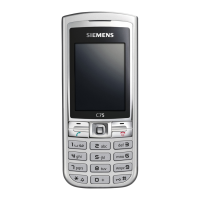Company Confidential s Com
Copyright 2005© Siemens AG
Page 21 of 37
Service Repair Documentation
Level 2.5e – C75
Release 1.0
–
Baseband receive path
In the receiver path the antenna input signal is converted to the base band, filtered, and
amplified to target level by the RF transceiver chipset. The resulting differential I and Q
baseband signals are fed into the S-GOLDliteTM. The A-to-D converter generates two 6.5
Mbit/s data streams. The decimation and narrowband channel filtering is done by a digital
baseband filter for each path. The DSP performs for GMSK, the complex baseband signal
equalization with soft-output recovery and the channel decoding supported by a Viterbi
hardware accelerator. The recovered digital speech data is fed into the speech decoder
(D1300). The S-GOLDliteTM supports fullrate, halfrate, enhanced fullrate and adaptive
multirate speech codec algorithms.
Baseband transmit path
In the transmit direction the microphone signal is amplified and A-to-D converted by the
D1300. The prefiltered and A-to-D converted voice signal passes a digital decimation filter.
Speech and channel encoding (including voice activity detection, VAD, and discontinuous
transmission, DTX) as well as digital GMSK modulation is carried out by the S-GOLDliteTM.
The digital I and Q baseband components of the GMSK modulated signals (48-times
oversampled with 13 MSamples/s) are D-to-A converted. The analog differential baseband
signals are fed into the RF transceiver chipset. The RF transceiver modulates the baseband
signal using a GMSK modulator. Finally, an RF power module amplifies the RF transmit
signal to the required power level. The S-GOLDliteTM controller software controls the gain of
the power amplifier by predefined ramping curves (16 words, 11 bit). The S-GOLDliteTM
communicates with the RF chip set via a serial data interface.
The following algorithms and a task scheduler are implemented on the DSP:
Algorithms running on the DSP:
• scanning of channels, i.e, measurement of the field strengths of neighbouring base
stations
• detection and evaluation of Frequency Correction Bursts
• equalisation of GMSK Normal Bursts and Synchronisation Bursts with bit-by-bit soft-
output
• Synch burst channel decoder
• channel encoding and soft-decision decoding for fullrate, enhanced-fullrate and
adaptive multirate speech, and control channels as well as RACH, PRACH
• channel encoding for GPRS coding schemes (CS1-CS4) as well as USF detection
algorithms for the Medium Access Control (MAC) software layer
• fullrate, enhanced fullrate and adaptive multirate speech encoding and decoding
• support for fullrate (F9.6, F4.8, and F2.4) data channels
• mandatory sub-functions like – discontinuous transmission, – voice activity detection,
VAD – background noise calculation
• generation of tone and side tone
• hands-free functions (acoustic echo cancellation, noise-reduction)
• support for voice memo

